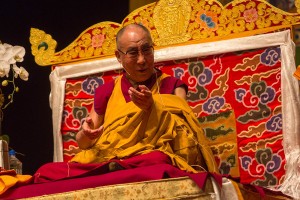His Holiness the Dalai Lama delivered five days of teachings in Mexico, with a further three days in the United States.
42,000 people attended His Holiness’ Mexican talks, with several thousand present for a speech at Universidad Pontificia de México, a Mexican university established by the Vatican Holy See. His first teachings, a three day audience at the Arena Ciudad de Mexico in Mexico City, began on October 12. Two shorter talks were held on October 15 and 16 at other locations in Mexico.
The initial teachings focused on A Guide to the Bodhisattva’s Way of Life by Shantideva. The ten part text describes a method for cultivating the “opening heart”, a state of mind which prepares the practitioner for a life of compassion and Buddhahood.

At the conclusion of the public talk in Mexico City, Mexico on October 14.
Photo: Jeremy Russell/OHHDL
His Holiness began with a note on what is to be gained by studying other religions. “All the major religious traditions hold the practice of love and compassion… tolerance and forgiveness, self-discipline and contentment”, he said, “Since we all teach about these things, we can properly learn from each other about them”. Listeners were told that ignorance is the source of all unhappiness, and that only by deep consideration and understanding can we overcome the suffering of this world. He also suggested that “people are better to stay with the spiritual traditions they are born to”.
On October 18, the Dalai Lama gave the first of three days teachings in the United States.

His Holiness the Dalai Lama with a group of Chinese writers after their meeting in New York on October 21.
Photo: Jeremy Russell/OHHDL
The teachings took place at New York’s Beacon Theatre, examining several Buddhist texts, including The Heart Sutra, The Sutra of Truly Remembering the Sublime Three Jewels, and the chapter on The Perfection of Wisdom from Shantideva’s Bodhicaryāvatāra. The talk was named The Virtue of Nonviolence, and promoted inner peace and communal harmony.
When asked by a member of the audience how his Holiness combats laziness, he answered “Oh, I’m quite a lazy person too. The key is to keep up your passion for what you are doing”.
The New York teachings were requested by The Gere Foundation and The Tibet Center, two American organisations which support cultural preservation within the Tibetan community.





 Print
Print Email
Email